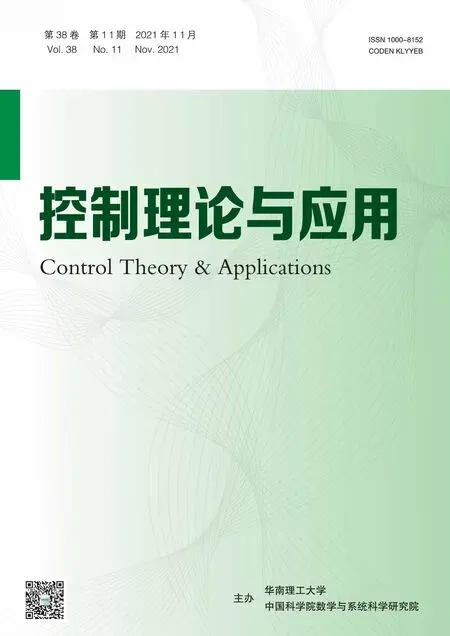Bearing-based localization of multi-agent system with event-triggered strategy
2022-01-08HUBinbinZHANGHaitao
HU Bin-bin, ZHANG Hai-tao
(Key Laboratory of Image Processing and Intelligent Control,School of Artificial Intelligence and Automation,Huazhong University of Science and Technology,Wuhan Hubei 430074,China;State Key Lab of Digital Manufacturing Equipment and Technology,Wuhan Hubei 430074,China)
Abstract: This paper develops an event-based scheme to attain bearing-based localization of multi-agent system in arbitrary dimension.Essentially,an event-triggered localization law is designed accordingly to the bearing rigidity,which is to localize all the agents in a static network given the bearings of a subset of agents. The conditions guaranteeing asymptotically stability of the closed-loop MAS governed by the proposed controller are derived with the assistance of input-to-state stable (ISS) principle. Significantly, Zeno behavior is excluded as well. Finally, 2-D and 3-D numerical simulations are conducted to substantiate the effectiveness of the proposed event-triggered localization control scheme.
Key words:localization;bearing rigidity;event-triggered control;multi-agent system
1 Introduction
In recent years,collective control of the multi-agent systems(MASs)has attracted more and more attention due to its extensive applications in multi-robot collaboration,multiple unmanned system localization,wireless sensor network optimization, and so on [1-14]. Taking the localization control of the networked system for example, the localization technology is indispensable for smuggling detection, contour mapping, environment surveillance,resources exploration,etc.
The objective of MAS localization is to localize all the agents in a static network with the assistance of the locations of a subset agents and inter-neighbor relative measurements.According to the types of measurements utilized in the localization, the existing works can be classified into position-based[15-17],distancebased[18-21]and bearing-based strategies[22-25].
Due to the associated theoretical challenges,initial efforts are devoted to the methods according to positions and distances[15-21],which are however heavily costly due to the high-accuracy binocular vision sensors and GPS devices.Moreover,in modern complex collective missions like aquatic resource exploration of multiunmanned surface vessels(USVs),efficient and precise position/distance sensors may not be always available,which intensifies the challenges in localization control.As a remedy,the bearing information(i.e.,bearing vectors or angles) only requires less costly onboard bearing sensors such as the pin-hole cameras and wireless sensor arrays[26], which is desirable in modern largescale applications to fulfill more and more complex marine missions.Therefore,it becomes an urgent tendency to develop a more practical and economic localization control scheme of the MASs merely based on relative bearing measurements.
In localization control techniques with bearingbased measurements, one of the main challenges lies in the nonlinearity of the bearing controllers,and hence the early stage works only focused on subtended bearing angles.As one of the pioneer works,Basiri&Bishop[27]proposed a bearing-only control scheme which governs three mobile agents to form localization with evenly-distributed angular phases.Zhao&Lin[28]designed a bearing-only protocol to form a cyclic localization with angular constraints. Eren & Tolga [29]developed a pattern controller for the localization of robots and sensor networks. However, such subtended bearing-based control protocols[27-29]still lack flexibility due to the invariant angles in agent’s local coordinates, which thereby hinders their further applications.Afterwards,another research line of bearing rigidity emerged,which achieves a specified localization by setting desired bearing vectors with local calculation. In this pursuit,Franchi et al.[30]initially studied the concept of bearing rigidity. Zhao & Zelazo [31] designed a nonlinear distributed bearing-only controller without a global orientation. This scheme was afterwards [32]generalized to a protocol to form translational and scaling localizations considering external disturbances, input saturations, and collision avoidance, simultaneously. Following this research line, Tron & Thomas [33]developed a gradient-decent optimization control law to minimize the localization error and control cost of the bearing-only schemes.However,due to the increasingly pattern complexity to fulfill specific localization missions in real applications,more recent efforts have been devoted to bearing-only localization control for highorder MASs. As representive works, Zhao et al. firstly revealed necessary-sufficient conditions for network localizability with rigidity theoretic interpretations[34]and then designed a novel bearing-only control law to attain localization with a variety of agent dynamics including single-integrator, double-integrator, and unicycle models[35].
So far, most of the existing bearing-only localization studies [22-35] just focused on the time-driven methods,which may not be suitable due to the widelyused embedded microprocessors with limited calculation resources. Moreover, data transmissions of currently available communication capability of bearing sensors further limit the applications to large-scale localization missions. As a remedy, event-triggered schemes [36-37] have attracted more and more attention, whose core idea is to trigger the controller only when a local measurement error exceeds a threshold.An event-triggered scheme basically consists of two elements, i.e., a distributed controller to govern each agent,and a triggering function determining what time to be updated[38-42].Compared with time-driven methods, event-triggered schemes could reduce calculation,communication and sampling cost whereas maintaining satisfactory control performances.However,due to the theoretical challenges in synthesizing the bearing input saturation constraints of bearing rigidity and eventbased dynamics, so far few efforts have been devoted to the event-triggered localization control with bearing rigidity. That naturally motivates us to develop a niche event-triggered bearing-only localization controller.
As an initial exploration of bearing-based MAS localization control with event-triggered techniques, the main contribution of this paper is to propose an eventtriggered bearing-only controller to localize all the agents in arbitrary dimensions, where the Zeno behaviors[36]are theoretically guaranteed to be excluded in the proposed framework.
The remainder of this paper is organized as follows:Section 2 presents problem formulation. Section 3 develops an event-triggered scheme for bearing-based localization.Moreover,the conditions are derived to guarantee both the closed-loop stability and the Zeno-free feature in the same section.Afterwards,numerical simulation are conducted to substantiate the effectiveness of the proposed method in Section 4. Conclusions are finally drawn in Section 5.
Throughout the paper,R,R+denote sets of the real and positive real numbers,respectively.Rndenotes then-dimensional Euclidean space.‖∗‖is the Euclidean norms, 1m:= [1···1]T∈Rm,In ∈Rn×nis the identity matrix.⊗denotes the Kronecker product,(∗)i,jrepresents the(i,j)-th entry of matrix∗,λmin(∗)denotes the smallest eigenvalue of symmetric matrix(∗), and∇(f) is the gradient of a functionf. GivenPk ∈Rq×qfork= 1,··· ,m, diag{Pk} ∈Rmq×mqrepresents a block-diagonal matrix with diagonal entriesP1toPm.
2 Problem formulation
Consider a leader-follower MAS with the firstlagents as the leaders, i.e., Il:={ν1,ν2,··· ,νl}and the reminderf:=n −lagents as the followers,i.e., If:={νl+1,νl+2,··· ,νn}, defineG(ν,ε) as the undirected interaction topology among agents withν= [ν1ν2··· νn] = Il ∪Ifthe vertex set andε ⊆ν×νthe edge set.Ni={j ∈ν,(i,j)∈ ε}denotes the neighbors of agenti,where the connection(i,j)represents agentihas access to agentj.
Letpi ∈Rdbe the positions of agentiwith the dynamics formulated as below,
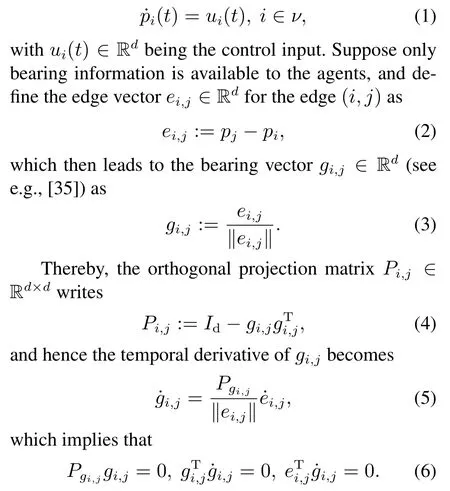
Before deriving the control law, it is necessary to give the following definitions concerning bearing rigidity.
Definition 1 (oriented graph [43]) An oriented Graph is an undirected graphG(ν,ε) with an assignment of a direction to each edge.
Letmbe the number of undirected edges inG, it can be deduced that the oriented graph containsmdirected edges. Suppose the edge (ki,kj),ki,kj ∈νinGcorresponds to thek-th directed edge in the oriented graph withk ∈M:={1,··· ,m},in other words,
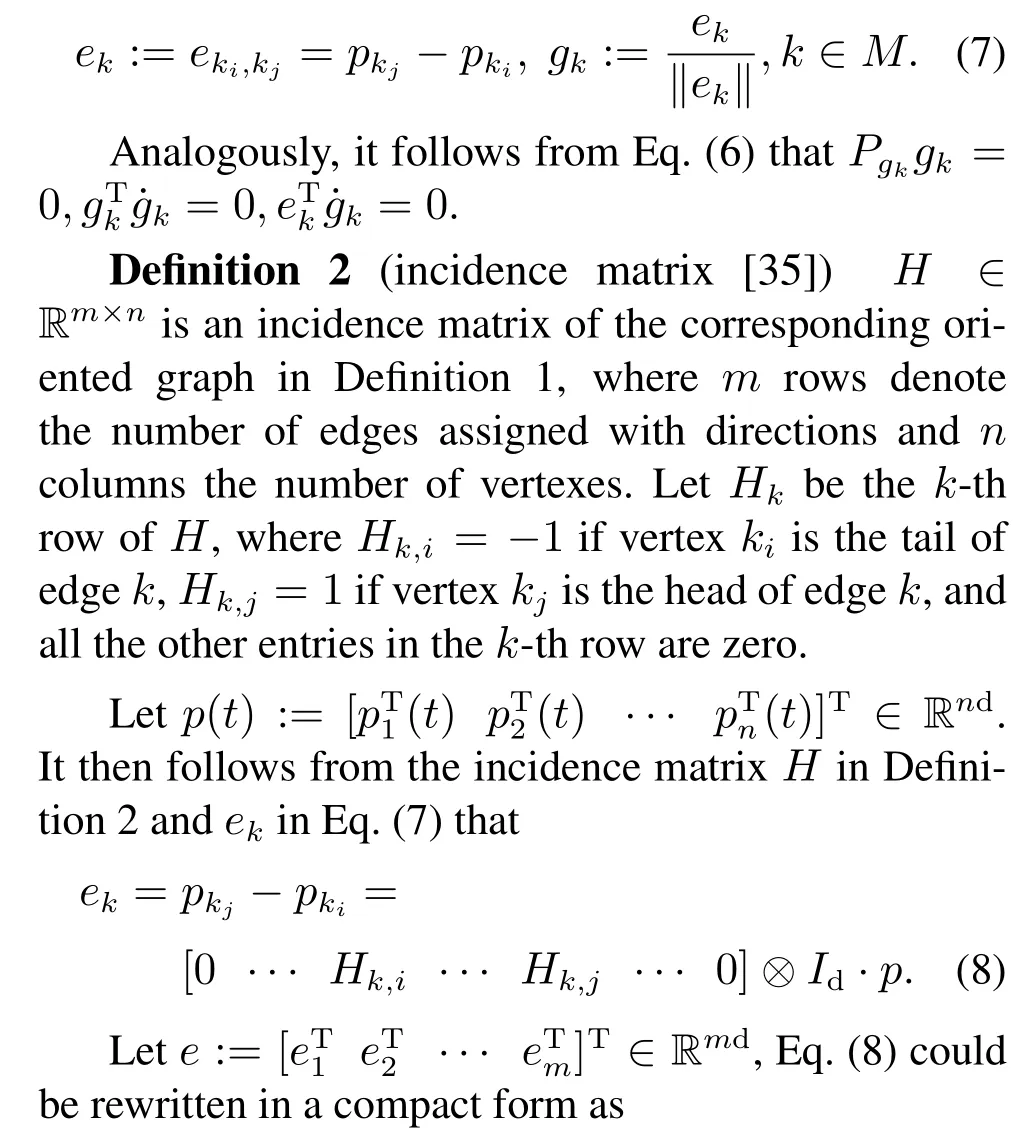
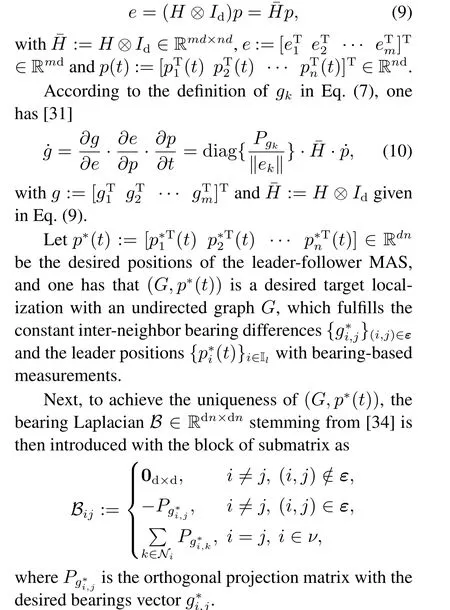
In accordance to the definition of leader-follower MAS(Il ∪If),the bearing LaplacianBcould be partitioned into

withBll∈Rdl×dl,Blf∈Rdl×df,Bfl∈Rdl×df, andBff∈Rdf×df.
To propose the main technical result,it is still necessary to provide a definition concerning the unique target localization.
Definition 3 (unique target localization [35])The desired target localization (G,p∗(t)) is unique ifBffin the bearing LaplacianBis nonsingular.
With the above definitions,it is ready to propose the main technical problem addressed by this paper.
Problem 1(event-triggered bearing-based localization).With the given anchors leaders(i.e.,ui= 0,i ∈Il),design a coordinative event-triggered control signal

for the followers in MAS governed by Eq. (1) andG(ν,ε) to achieve a unique localization given in Definition 3. Here,s= 0,1,2,···, are the discrete event-triggering time constants.The triggering time sequencests,s= 0,1,2,··· ,are calculated with a trigger functionf(·)designed afterwards.
Remark 1 Distinct from previous time-driven bearing-only control methods [27-35] and eventtriggered position-based control strategies [37-42],Problem 1 considers both natural nonlinear bounded bearing values (i.e.,‖gi,j‖≤1 in Eq. (7)) and eventtriggered techniques for technical issues, which brings challenges in controller design, stability analysis and Zeno exclusion.
3 Main results
In this section,the event-triggered bearing-only localization control scheme is proposed with a guaranteed Zeno-free feature.Before presenting the main technical results,it is necessary to introduce some preliminaries.
Assumption 1 For ann-agent MAS with communication topologyG(ν,ϵ),it is assumed that the target localization(G,p∗)in Definition 3 is unique.
Assumption 1 guarantees the uniqueness of the final localization via bearing-only measurements.
Lemma 1[35] Suppose no agents coincide in desired localizationp∗or during the localization forming process,one has
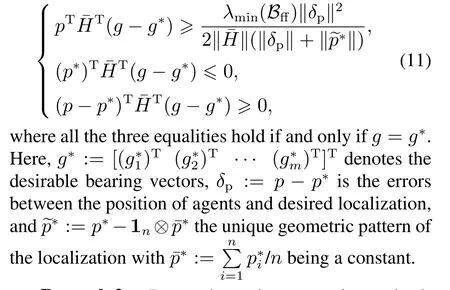
Remark 2 Due to the anchors or stationary leaders(i.e.,ui= 0,i ∈Il)and the unique target localization in Definition 3, it can be deduced that the desired positionp∗is stationary, which implies that the center of all the desired positions ¯p∗keeps stationary as well(i.e.,a constant)in Lemma 1.
Assumption 2 [35] Under Assumption 1, it is assumed that the initial values of position errorsδpin Eq.(11)satisfy

withβ>0 being a positive constant.
Assumption 2 is a sufficient condition for initial noncoincidence of agents, which is indispensable for the exclusion of the Zeno behavior afterwards.
Analogously, in accordance to the stationary anchor leaders i.e.,pi(t) =pi(0), i ∈Il, ∀t> 0 in Problem 1,the proposed event-triggered control lawui, i ∈If,is formulated as,

whereγi ∈R+,i ∈If,is the control gain, ands=0,1,2,···, are the discrete event-triggering time constants. The triggering time sequencests,s= 0,1,2,··· ,are designed as
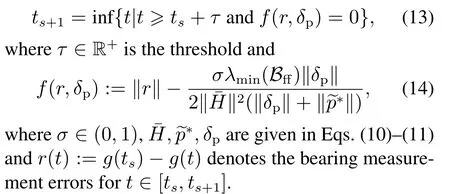
Now, the main technical result concerning Problem 1 is provided as below.
Me: How s the salmon2?Server: Fantastic!Me: Does it come with rice?Server: Absolutely!Would a good and a yes have been sufficient? Undeniably!At Starbucks, the smallest coffee you can order is a Tall
Theorem 1 For the leader-follower MAS governed by Eqs.(1)(12),and(14),Problem 1 is solved under Assumptions 1, 2. Moreover, the inter-event times satisfyts+1−ts≥τwithτ ∈R+being the threshold.
Proof See Appendix.
Remark 3 In the previous event-triggered control strategies [37-42], the input is generally designed based on the relative position, which implies that at least two kinds of sensors are required (distance measurement and bearing angle measurement) with high cost.However,the proposed controller in Eq.(12)is designed based on bearing-only information,which could measure bearings via only low-cost pin-hole cameras or wireless sensor arrays,and is hence more applicable in practice.Moreover,since the relative bearing is nonlinear and bounded,it brings challenging issues in the convergence analysis and exclusion of Zeno behavior when combining it with event-triggered technique.
4 Numerical simulation
In this section, we consider two kinds of localizations to validate the feasibility of Theorem 1. One is a 3-D localization,another is a sophisticated localization in a 2-D configuration space.
For a 3-D localization scenario, we consider a leader-follower MAS consisting of 2 leaders and 10 followers,whose inter-agent interaction topologyGof the MAS is illustrated in Fig. 1(a) under Assumption 1.Moreover,with an arbitrary oriented graph of the topologyG, the target localization is set with the constant bearingg∗and prescribed relative distance, as shown in Fig.1(a).The initial positions of the leader-follower MAS are set as
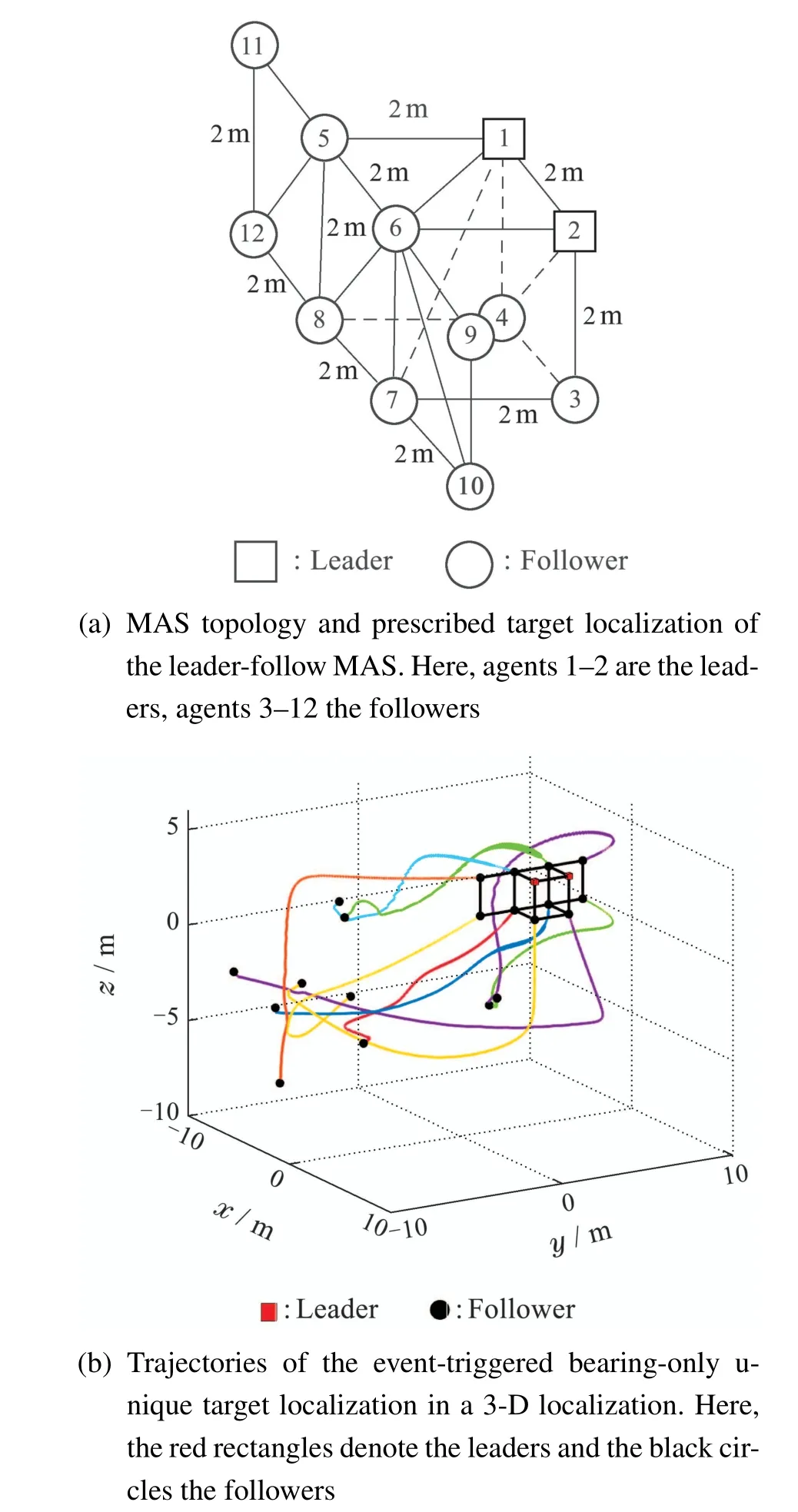
Fig.1 MAS prescribed structure and trajectories evolution in 3-D localization
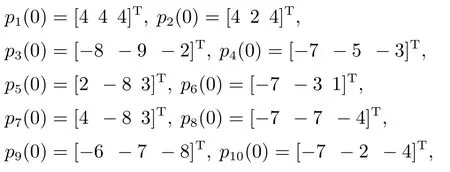

with Assumption 2. In accordance to Theorem 1, the parameters for controller(12)are set asγi=10,i ∈Ifandσin Eq.(a6)is set as 0.5 satisfying 0<σ<1.
The trajectories of the event-triggered bearing-only localization are illustrated in Fig.1(b),where the black circles denote the positions of followers and the red rectangles the positions of leaders. It is observed that the prescribed target 3-D localization is finally achieved by the followers in Fig.1(b).Compared with the timedriven bearing localization method [35], the evolution of bearing vector errorsg −g∗in Fig. 2 converge to zeros as well and hence the prescribed target localization is finally achieved, which substantiates the feasibility of Theorem 1. As shown in Fig. 3(a), with substantial reduction of the calculation,sampling and communication cost,there is nearly no control performance degradation of the tracking errors‖δp‖, which still converge asymptotically with the event-triggered controller. Moreover, as shown in Fig. 3(b), the temporal evolution of the event-triggered timests+1−tsimplies that there exists a minimum inter-event time interval ofτ= 0.02 s, which further verifies the feasibility and effectiveness of the control scheme Eq. (12) and Theorem 1.Fig.4 depicts the event-triggered phenomenon by the switching of the trigger functionf(r,δp).
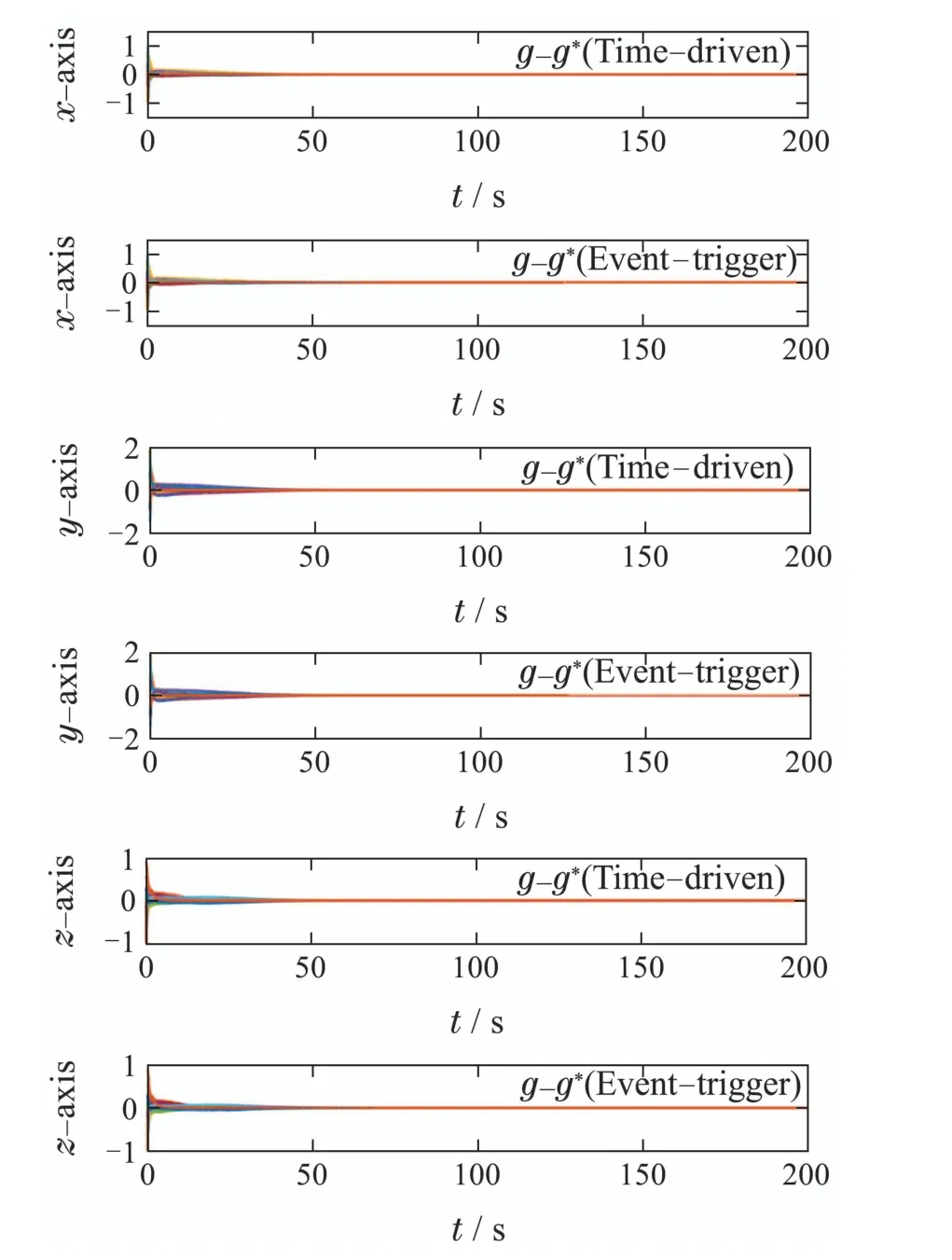
Fig.2 Temporal evolution of the bearing vector errors g −g∗in 3-D localization
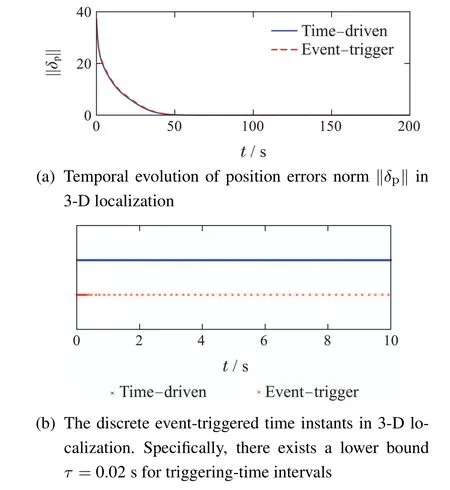
Fig.3 Performance evolution of MAS localization with event-triggered schemes in 3-D localization
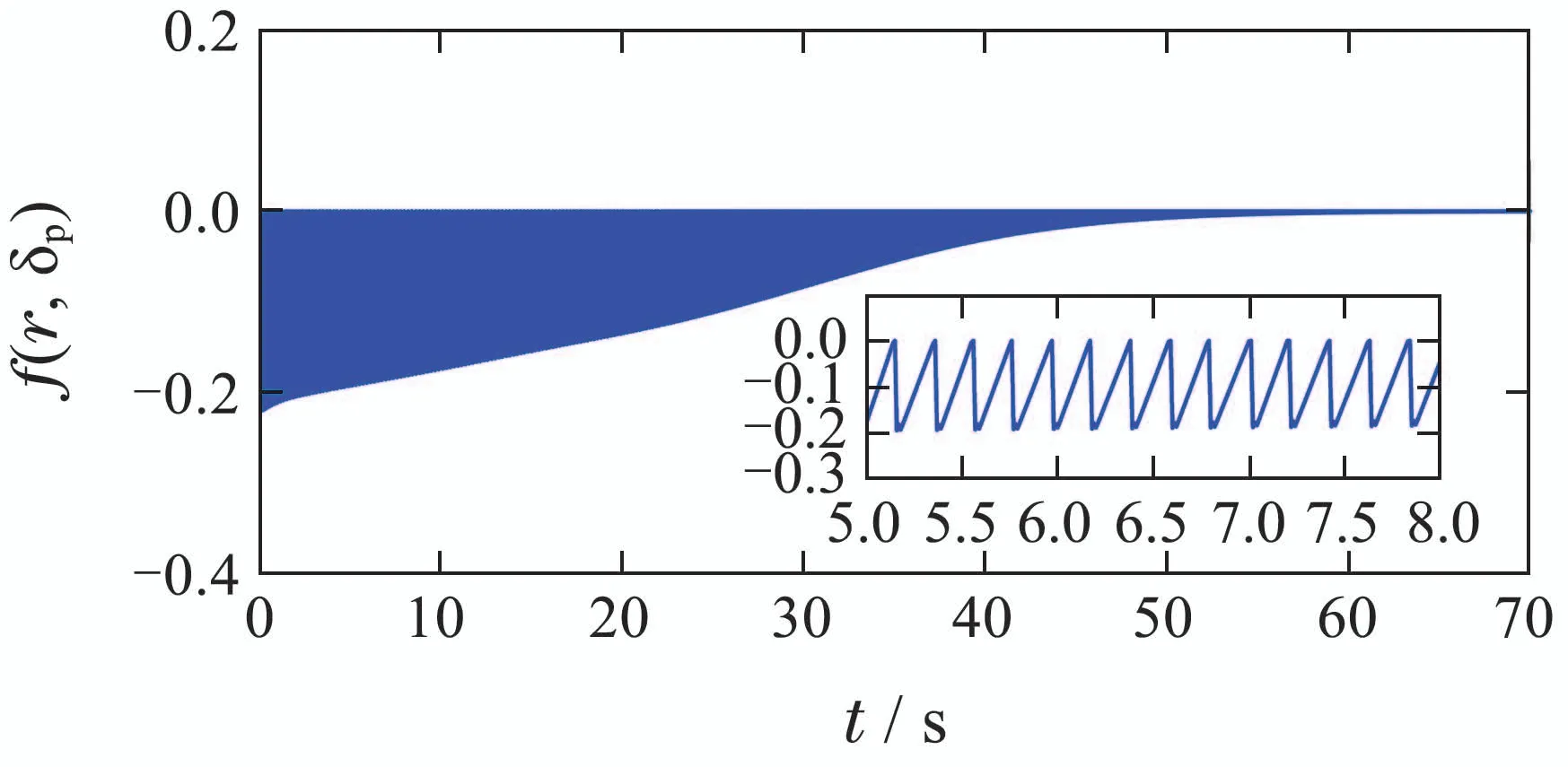
Fig.4 Temporal evolution of the triggering function f(r,δp)in 3-D localization
For the scenario of 2-D localization case, we consider a leader-follower MAS consisting of 2 leaders and 14 followers,whose inter-agent interaction topologyGof the MAS is illustrated in Fig. 5(a) under Assumption 1.Meanwhile,the target localization is set with the constant bearingg∗and prescribed relative distance,as shown in Fig. 5(a) as well. The initial positions of the leader-follower MAS are set as
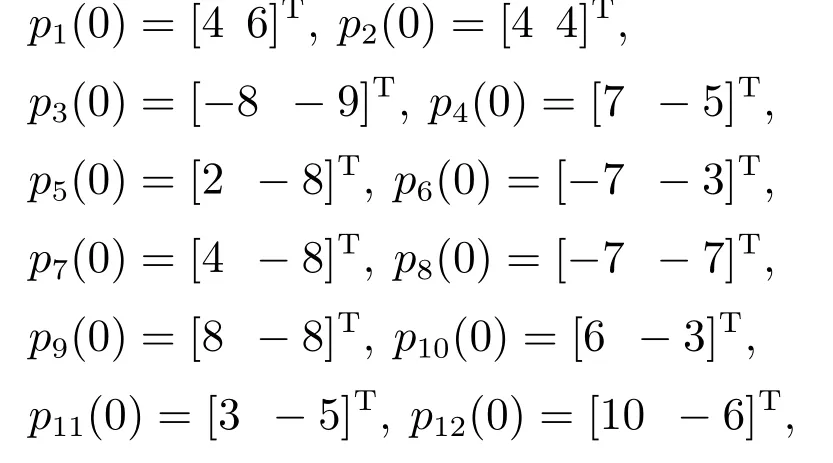

with Assumption 2. The parametersγi= 10,i ∈Ifandσin Eq.(a6)for controller(12)are the same as the 3-D case.
Analogously,the trajectories of the event-triggered bearing-only localization are illustrated in Fig.5(b).It is observed that the prescribed target localization is finally achieved by the followers as well. The evolution of bearing vector errorsg −g∗in Fig.6 converge to zeros as well, which implies that the prescribed target localization is finally achieved. As shown in Fig. 7(a), the tracking errors‖δp‖still converge asymptotically with event-triggered controller,which is similar to Fig.4(a).Moreover, as shown in Fig. 7(b), the temporal evolution of the event-triggered timests+1−tsclearly imply that there exists a minimum inter-event time interval ofτ= 0.02 s, which verifies the feasibility and effectiveness of the control scheme (12) and Theorem 1 as well. In Fig. 8, it is observed that the event-triggered phenomenon implicitly exists by the switching of the trigger functionf(r,δp).
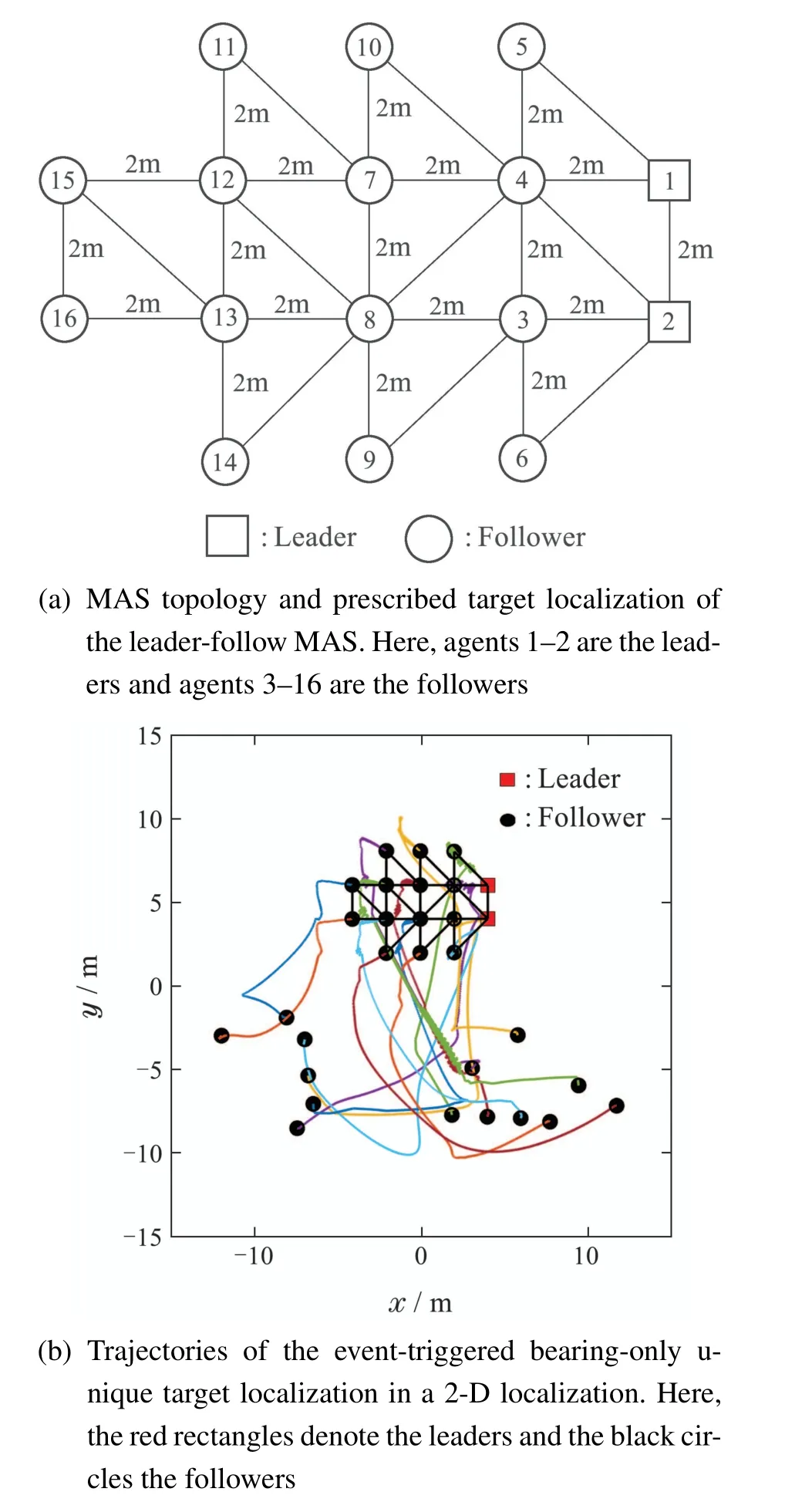
Fig.5 MAS prescribed structure and trajectories evolution in 2-D localization

Fig.7 Performance evolution of MAS localization with event-triggered schemes in 2-D localization
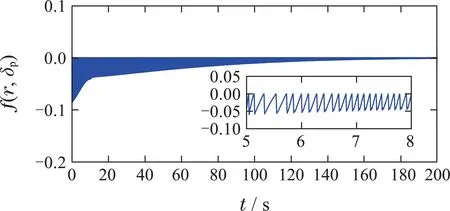
Fig.8 Temporal evolution of the triggering function f(r,δp)in 2-D localization
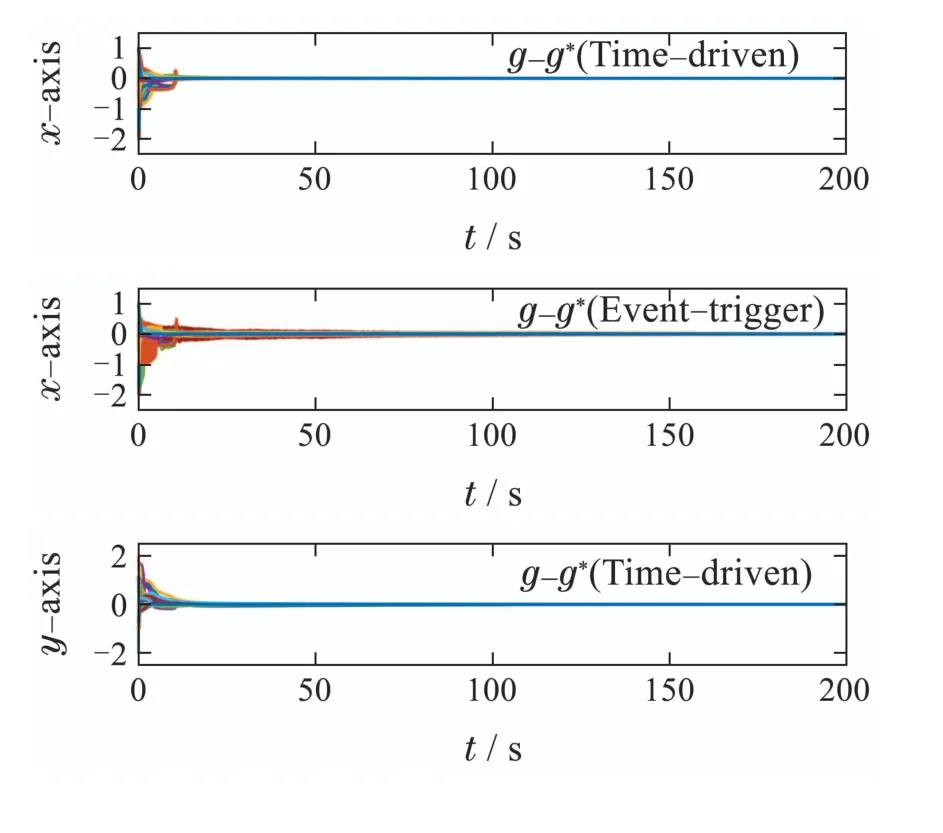
5 Conclusion
In this paper, we propose an event-triggered bearing-only localization method for networked MASs.With such a localization protocol,the entire group forms a prescribed localization merely according to eventbased bearing-only measurements in arbitrary dimension. Essentially, the conditions are derived guaranteeing both the asymptotical stability of the proposed protocol and the exclusion of Zeno behavior. Numerical simulations are conducted to substantiate the effectiveness of the proposed method. Such an event-based bearing-only method has application potential in collective patrolling, reconnaissance, resource explorations,environmental monitoring,etc.,with abundant industrial multiple unmanned systems,mobile robots and vehicles.
Appendix Proof of Theorem 1
The proof consists of two claims,where the convergence of bearing-based localization and exclusion of the Zeno behavior are proved sequentially.
Claim 1 Convergence of bearing-based localization.
With the assistance of the incidence matrix ¯Hin Eq. (9),rewrite the controller Eq.(12)in a compact form as
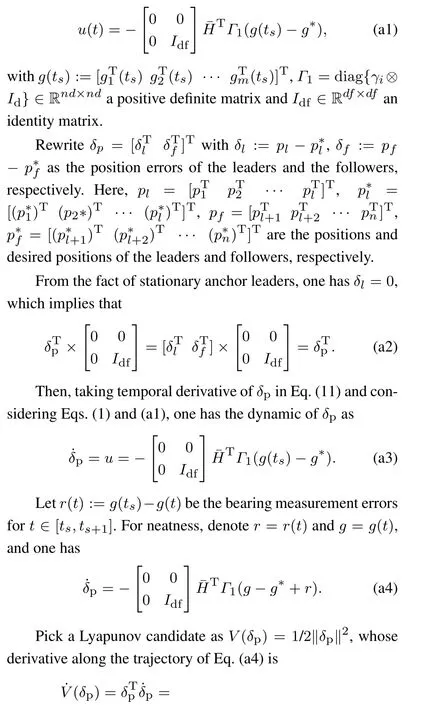
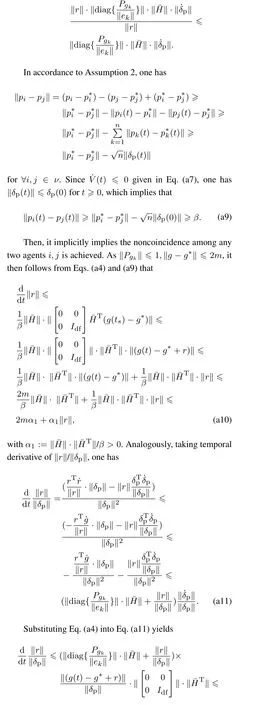
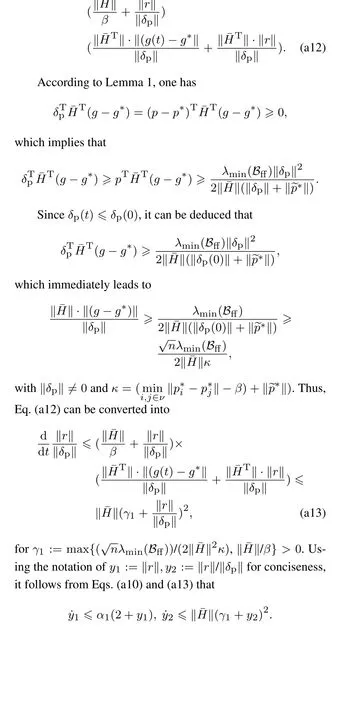
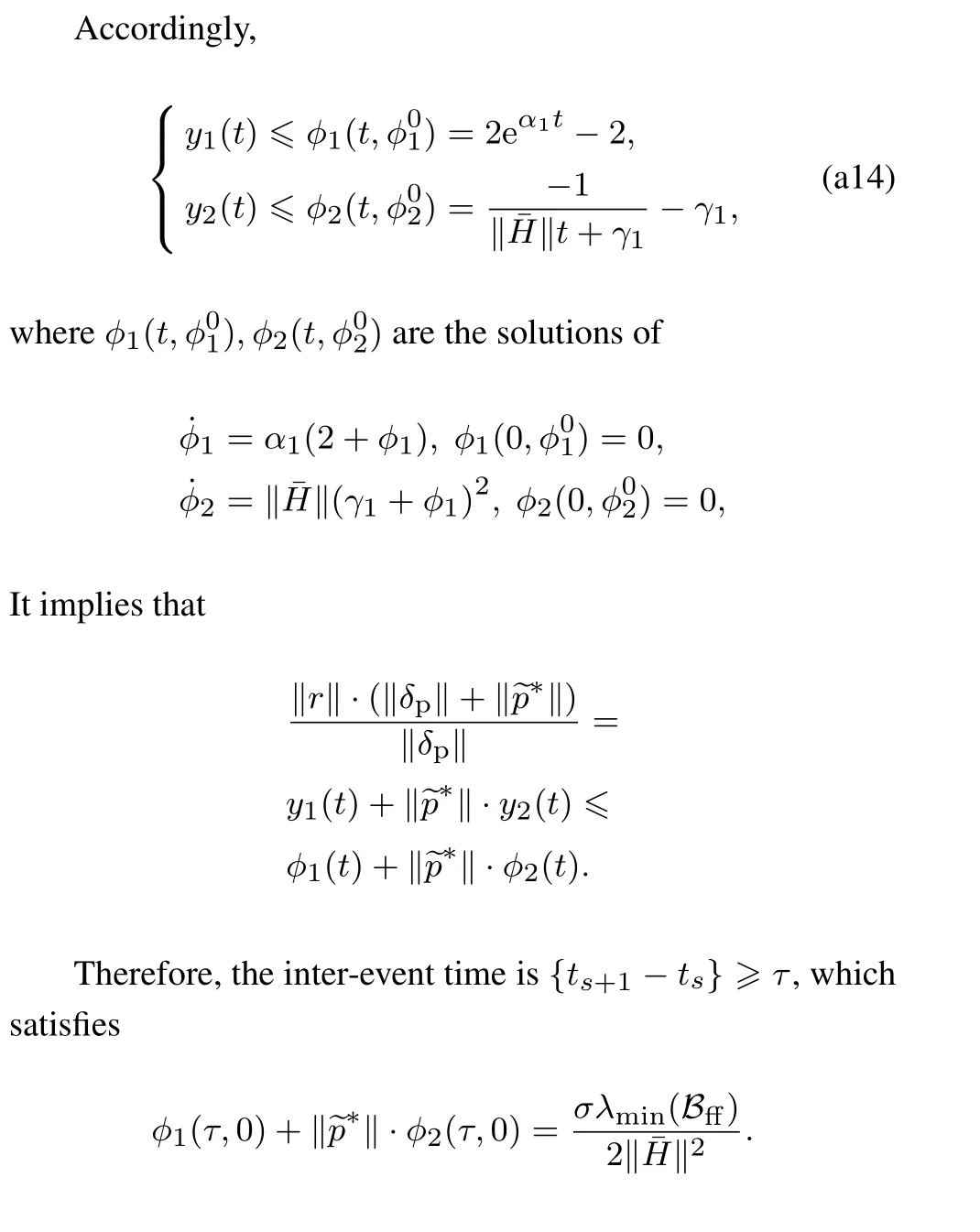
According to the monotonically increasing property ofφ1,φ2in Eq.(a14),there exists a lower time boundaryτsuch that{ts+1−ts}≥τwith a parameter 0<σ< 1.The proof is thus completed.
